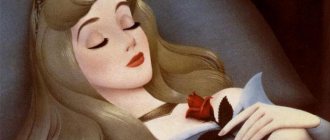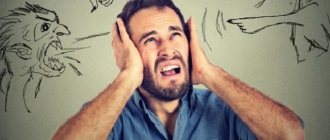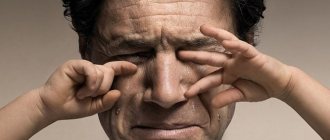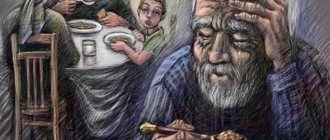Hallucinations are understood as a person’s pathological perception of phenomena that actually do not exist. They almost always signal a mental disorder. In this article we will talk in detail about what to do if hallucinations occur in older people.
Repeated illusions almost always signal the development of a pathological process
general information
Sometimes illusions arise for no apparent reason.
Hallucinations in older people can be:
- reflex;
- spontaneous;
- functional.
Spontaneous hallucinations occur for no apparent reason. Specific processes occur in the brain that affect the organs of vision and hearing.
Against the background of stimulation of another organ, reflex disorders occur. When directly exposed to the analyzer, functional hallucinations appear.
Main types of hallucinations
The table shows the main types of disorders.
Table 1. What types of hallucinations are there?
| Type of disorder | Description |
| They can be elementary and subject-specific. In the first case, a person “sees” flashes of light, geometric shapes or fog, in the second - animals or “inhabitants” of another world. |
| Can be elementary and verbal. In the first case, the patient “hears” various sounds, noises, and voices. Verbal auditory hallucinations may be threatening, commentary, or imperative. |
| May overlap with olfactory illusions. The patient imagines disgusting smells - garbage, decaying bodies, excrement. This contributes to loss of appetite. |
| Often combined with olfactory illusions. The patient feels that there is a rotten smell in the mouth. |
| They can be hygric, thermal, haptic. More often, people feel as if insects are crawling on or under their skin. This condition is called external zoopathy. |
Classification of hallucinations
Before figuring out what to do with a patient if he experiences hallucinations and what treatment can be undertaken by qualified specialists, we recommend that you familiarize yourself with the description of this deviation and its most common forms.
Changes in the subjective perception of reality are classified into 2 large groups: pseudohallucinations and true hallucinations. The latter are further divided into the following categories:
- spontaneous – appear in the absence of external stimuli;
- reflex - can be noted in any of the analyzers when irritation is provided to another perceptive organ;
- functional - appear when influencing the corresponding analyzer, but are perceived by patients in a distorted form.
In accordance with which particular analyzer is susceptible to pathological effects, hallucinations are classified into the following subgroups:
- auditory;
- visual;
- taste;
- tactile;
- olfactory;
- vestibular, etc.
In accordance with average statistical data, auditory and visual hallucinations are most widespread. In the first case, the patient either hears existing sounds in a distorted form, or hears something that does not exist, including the voices of deceased relatives, “evil spirits,” etc. Visual hallucinations usually appear in the form of flashes of light and geometric shapes, but can “evolve” into more complex forms: people, animals, mythical creatures, etc.
Common Causes of Illusions
The main causes of senile hallucinations are presented in the diagram.
The most common provocateur is the abuse of hallucinogens
Taking medications
The risk of illusions occurs with the following drugs that cause side effects:
- sulfonamides;
- antiviral drugs;
- antibiotics;
- anticonvulsants;
- antihypertensive drugs;
- psychostimulant drugs
Note! These drugs cause auditory, tactile and visual hallucinations.
Pathological causes
The occurrence of pathological causes that can cause hallucinations is indicated in the diagram.
The disorder may occur due to schizophrenia
Diseases-root causes
Hallucinations in old people can be caused by severe mental pathologies.
Table 2. Diseases-root causes.
| Cause | Description |
| Illusions appear against the background of a violation of the medication regimen. |
| The provocateur of hallucinations is a neurodegenerative process. It affects the cells that are responsible for producing dopamine. |
| The disorders are chronic and persistent. |
Other reasons
The incidence of other causes of hallucinations in older people is shown in the chart.
The disorder is almost always caused by damage to the temporal lobe
Why do old people hallucinate?
Hallucinations are a manifestation of an abnormal perception of the present, sensations and images that randomly appear in the mind of an old person. They are not a consequence of the influence of stimuli, so people begin to consider them an objective reflection of reality.
Hallucinations are quite a serious problem, especially for an elderly person. Communicating with sick old people is already difficult, and if their worldview is also impaired, then this becomes a real disaster. What is the reason for hallucinations in an old person? Often, even doctors cannot understand what is going on here, but it is also impossible to ignore the problem.
Hallucinogenic states can be a consequence of any disease, or they can arise spontaneously. Let's look at the main reasons.
Not related to diseases:
- If an old person takes hallucinogenic drugs.
- As a side effect of a medication. For example, antibiotics, antiviral drugs, tranquilizers. Isolation from society, as well as confined space.
- Disturbance in sleep patterns and daytime activity.
Related to illnesses:
- Schizophrenia, epilepsy and other diseases caused by mental disorders.
- Hallucinations resulting from intoxication after poisoning.
- Benign and malignant brain tumors.
- Psychosis due to infectious diseases.
- Alzheimer's and Parkinson's diseases.
- Progressive paranoia.
Old people struggling with illness tend to become paranoid due to chronic depression and pessimism, as they think that they will die soon. Features of the disease directly affect the nature of hallucinations.
There are other prerequisites for a distorted perception of reality:
- Panic attacks, which manifest themselves in older people as disturbances of perception, including hallucinations. An elderly person cannot overcome this disease on his own without the help of a specialist.
- Delirious syndrome resulting from chronic alcoholism. This pathology is also accompanied by hallucinations. In addition, in cases where an old person begins to behave inappropriately and is very excited, we can also talk about the presence of vascular diseases of the brain.
We recommend
“Diseases of the elderly: diagnosis, prevention, treatment” Read more
Forms of hallucinations in the elderly
The tablet presents the main forms of senile hallucinations.
Table 3. Common forms of hallucinations in the elderly.
| Form | Age | Description | Symptoms |
| From 80 years old. | The syndrome begins very acutely. Symptoms increase gradually. First, the patient sees individual light or colored spots, then the hallucination takes on a scene-like character. | The patient's consciousness is presented with views of nature, familiar and unfamiliar people, and animals. Usually a person understands that all this is an illusion, but sometimes he becomes involved in the events that appear to him. |
| From 70 years old. | People with poor hearing are at risk. Auditory hallucinations appear. | They are negative in nature. A person “hears” insults and threats. Mandatory hallucinations are rare. |
| 55-60 years old. | Hallucinosis is defined as “delusions of cutaneous insects.” Unpleasant sensations arise throughout the body. Most often it is tingling or itching. | A person feels as if there are foreign bodies on or under his skin. When detailing the hallucination, he can describe in detail the “parasites” that bother him. This condition is accompanied by delusions of a hypochondriac. A person is convinced that he is suffering from an incurable disease. |
| 60-65 years old. | At first, minor paranoid signs appear. The person claims that he is about to be attacked by loved ones or neighbors. | Over time, the patient clearly “hears” voices that confirm his guesses. In the most severe cases, hallucinations take on a schizophrenia-like hue. It seems to a person that someone else is controlling his thoughts. |
How to deal with old people who are hallucinating
An old man has hallucinations - what to do? Patients, knowing about the presence of disturbances in consciousness, may react differently to this fact. Many are afraid of the ridicule of others, so they carefully hide their illness, pretend, and say that they have nothing of the kind. As a result, it is often difficult to determine the presence of symptoms.
If close people know for sure about a relative’s diagnosis, they should put themselves in his position and make sure that the old person is not afraid of ridicule or aggression, but shows his true condition. Try to become an assistant in the fight against the disease. Then you can easily recognize the onset of symptoms, suppress attacks, control the disease, thereby providing effective and timely assistance. Your task is to identify an emerging problem at an early stage and prevent it from worsening.
Rules for communicating with old patients with hallucinations and delusions:
1. Consider the person’s emotional state.
We must always remember that disturbances in perception accompany both pleasant and terrible emotional experiences. Based on this, you first need to focus your attention on the emotions filling the consciousness of the old patient, and only then on the content of hallucinations. Let's give an example. Grandmother is afraid of the devil, who should come at 9 o'clock to torment her. Don't convince her that the devil is unreal, but discuss ways to help her feel protected.
2. Take care of safety.
We must strive to ensure that the patient and his environment feel safe and create optimally comfortable living conditions for everyone. There is no point in taking measures to stop the symptoms if the old relative calmly goes about his business and does not cause any inconvenience to anyone.
For example, an elderly loved one, returning home, receives messages on TV, but they do not bother him. Don't interfere, even if you really want to. But if you feel uncomfortable talking about voices, you can ask him not to talk about them in front of you.
3. Do not argue with the patient.
There is no point in disputing what the old patient dreamed. He actually sees and feels this way; all images are real for him. If you deny their existence or downplay the significance of hallucinations, you risk losing the trust of a loved one or even turning into their enemy. Then it will be more difficult to help him, and communication problems will only increase.
Not recommended:
- ridicule of the patient's condition;
- surprise or fear of his experiences;
- persistent belief in the insignificance of what is happening, when the patient takes all visions very seriously.
- discussing what the old person sees, as this increases the significance of the visions in his eyes.
It is better to address an old relative calmly, kindly and encouragingly:
- Ask about what he is hearing at that particular moment to get an idea of how he is feeling.
- Discuss a way out of this situation, how you can cope with your experiences and their causes.
- Help the patient feel protected. Make it so that he can control what happens to him.
- Tactfully express your thoughts that perhaps what is happening is just a hallucination. To do this, you need to select words so that the patient agrees with them.
- Remind the elderly patient that there are certain rules of conduct. But there's no need to get annoyed that he can't stick to them. He is sick, and therefore it is unacceptable to talk to him in a raised voice.
Old people are convinced of the reality of visions to varying degrees. Some understand that these are signs of a disease, while others want to know whether their fantasies are true. In the latter case, you will get a chance to prove that these are just hallucinations. However, there are patients who are completely convinced that all their visions are realistic. These people are in no hurry to give up their fantasies and zealously defend them.
Never argue about the unreality of nonsense, since it is impossible to prove it. If the sick person persists, simply answer in a calm tone that you have a completely different point of view on this issue.
We recommend
“Senile dementia: causes, symptoms, treatment” Read more
Visions before death
Hallucinations before death occur in older people if they die gradually.
Against the background of a sudden death, there are no visions.
Most people "are":
- angels;
- demons;
- souls of previously deceased relatives.
Sometimes a person begins to look around in fear, scream loudly, and after a while calms down. Answering questions from his relatives, he says that first he saw terrible devils, and then angels.
If an elderly person experienced excruciating pain, then after the visions his mood is transformed. In almost 100% of cases the pain disappears.
Categories of hallucinations and signs
Auditory illusions are the most common.
Patients wake up at night from a strange noise, hear individual words or phrases. It seems to them that the neighbors behind the wall are constantly talking or arguing, although they are actually at work or visiting. Some older patients begin to hear several voices discussing their actions and condemning past mistakes. Sometimes such hallucinations end in a suicide attempt. In other situations, an invisible interlocutor orders the patient to cripple himself or his relatives, warns that they want to poison the person or hack him to death in a dream, castrate him or take away his apartment and put him out on the street. Typically, such illusions are diagnosed in older people with mental disorders or paranoia.
The second position among the most common hallucinations is occupied by visual varieties. Old people see flashes of light, it seems to them that the house is full of smoke or fog. Some people see animals or human silhouettes; at night, devils or other mythological creatures from the other world come to them. Sometimes pensioners are pursued by aliens or their own doubles. Entire scenes can play out before the patient’s eyes, and he will never suspect that these are all just hallucinations.
Visual and auditory illusions are often complemented by olfactory or gustatory varieties. In the first case, an elderly person constantly smells unpleasant odors, such as carbon monoxide or rotting waste, or aromas that evoke pleasant associations in him. For example, it seems to my grandmother that the room smells of the favorite perfume of my grandfather, who died ten years ago, and she believes that his ghost really decided to visit her. In the second case, the patient refuses to eat because of the strange taste. Too salty, bitter, with a chemical taste. A sick person may knock over a bowl of soup because it seemed to him that his daughter or son-in-law had poured poison into it. Sometimes hallucinations cause panic attacks or attacks of paranoia.
What should I do?
If you have severe anxiety, you can give the patient a few drops of valerian tincture.
Instructions for hallucinations in an elderly person are as follows:
- Distract the patient. This can be done by changing the topic of conversation or inviting him to go to another place. This method is effective for mild hallucinations.
- Try to persuade him to seek medical help. It is advisable to do this after the disappearance of illusions. It is important not to take the “prosecutor’s position” and not to put strong pressure on the patient.
- If the patient is very worried, you can give him a sedative that has a mild effect. This could be Codeine, motherwort or valerian tincture.
- If severe physical symptoms appear, you should call an ambulance.
Note! When hallucinations worsen, there is a serious danger to the health of both the patient and those around him.
Which doctor should I contact?
If hallucinations occur, it is recommended to visit a therapist.
Depending on the characteristics of the clinical picture, the doctor will refer you for an appointment with:
- neurologist;
- narcologist;
- psychiatrist;
- oncologist.
Features of treatment
If the illusions were provoked by toxic substances, cleansing procedures are carried out.
Therapeutic principles are as follows:
- If hallucinations were provoked by alcohol or drugs, cleansing procedures are carried out. Substances that provoke intoxication are removed from the body. Individual therapy is then prescribed.
- If hallucinations occur against the background of a particular disease, medication is prescribed.
- After the attack has stopped, cognitive behavioral therapy is prescribed.
An acute attack is treated in a hospital setting. Then the patient is handed over to relatives.
What should you not do?
It is strictly forbidden to self-medicate.
In case of hallucinations, it is strictly not recommended:
- underestimate their danger;
- leaving an elderly person unattended;
- laugh at the patient’s feelings;
- persistently convince the patient that what is happening is delusional;
- discuss in detail the content of his visions.
Self-medication is strictly prohibited. Only a professional can provide qualified assistance during an attack.
Etiology of the problem
The leading role in the development of hallucinatory syndrome in elderly people is played by degenerative changes in the brain. What are these changes? The essence of degenerative changes is the restructuring of nervous tissue, when the sheaths of nerve fibers are destroyed and neurons are replaced by non-functional connective tissue. Such changes are characteristic of a number of diseases of old age. Among those often associated with hallucinosis are:
Parkinson's disease;- Alzheimer's disease;
- leukoencephalopathy;
- senile dementia.
Degenerative changes in the brain are irreversible and that is why the hallucinatory syndrome that occurs against the background of these disorders, as a rule, cannot be completely eliminated. But the disease can always be controlled, and if the patient regularly takes the medications prescribed by the doctor, then repeated episodes of perception disorders will most likely be avoided.
Senile hallucinations can also occur for other reasons. In second place are psychiatric diseases:
- schizophrenia;
- epilepsy;
- psychoses;
- bipolar personality disorder.
In such cases, the person’s illness has usually been known for a long time. And the exacerbations that one has to face in old age are distinguished by the severity of symptoms, as well as their development against the background of a noticeable deterioration in general well-being.
In addition, there are a number of situations that do not fit into any of the options described above. But in these situations there are quite often perception disorders, they are definitely worth remembering, for example:
Delirious syndrome. Delirium alcoholism is most often encountered in adulthood, however, sometimes this pathology develops in elderly patients suffering from alcoholism.- Panic attacks. Panic attacks, especially at night, are often accompanied by clinical perception disorders. And if at a young age such attacks “go away” on their own, then at an older age they need qualified medical care.
- The process of dying. A hallucination can occur before death, as part of the dying process. Most often this concerns patients exhausted by a serious illness (terminal stage of oncology, tuberculosis, etc.).
The reason for hallucinations in old people can be several reasons at the same time. Thus, quite often there is a combination of senile dementia and psychosis, which becomes the direct cause of perception disorder.
Drug therapy
Drug treatment of hallucinations in older people is carried out using:
- neuroleptics;
- tranquilizers;
- antidepressants;
- other drugs.
Note! Psychotropic medications are prescribed taking into account the general condition of the patient, the presence of chronic ailments and concomitant pathologies.
Use of antipsychotics
These are psychotropic medications that eliminate psychological and neurological problems. They contribute to:
- getting rid of hallucinatory-delusional syndrome;
- relieving muscle tension;
- improving the thought process.
The diagram shows the most effective antipsychotics.
The most expensive antipsychotic drug is Abilify
Use of tranquilizers
Drugs in this group are prescribed if hallucinations are provoked by an increased anxiety state.
Tranquilizers help relieve:
- panic;
- anxiety;
- stress.
Also, drugs in this group reduce internal tension. There is no effect on cognitive processes.
Table 4. The most effective tranquilizers.
| A drug | Description | Price |
| A benzodiazepine tranquilizer. It has anticonvulsant, nootropic and central muscle relaxant effects. | From 567 rubles. |
| Has an anxiolytic effect. Helps eliminate various forms of autonomic disorders. Has a moderate stimulating effect. | 359 rubles. |
| It has antiepileptic and central muscle relaxant effects. Does not cause extrapyramidal disorders. | 258 rubles. |
Use of antidepressants
The most effective antidepressants for hallucinations are presented in the diagram.
The most inexpensive antidepressant is Amitriptyline
Use of other drugs
The table contains other medications for hallucinations in older people.
Table 5. Taking other medications.
| Medicine | Description | Price |
| The drug helps reduce the conditioned defensive reflex. Strengthens the anti-anxiety effect, reduces delusions, hallucinations, and relieves negative disorders. | 2293 rubles. |
| It is a derivative of butyrophenone. It has a powerful antipsychotic effect, blocks postsynaptic dopamine receptors in the mesolimbic and mesocortical structures of the brain. | 44 rubles. |
| Thioxanthene derivative. Has a powerful sedative effect. | 223 rubles. |
How to get rid of hallucinations
People who do not experience this mental problem often make fun of hallucinations, since they are not given the opportunity to understand what they are and what the patients experience. Sometimes it is very scary, frightening and makes you doubt your mental health. At the same time, there are quite a few reasons for the origin of visions and sounds, so you should not delay, but you should contact the professionals of our Center as soon as possible. As a rule, the patient may not realize that they are hallucinating, and may experience severe fear, anxiety, and anger. This condition is more often noticed by loved ones, and it is they who should insist on a visit to the doctor.
First of all, the specialist will identify the “culprit” of the hallucinations. This could be poisoning, various disorders, or more serious problems that require careful examination. After this, treatment is prescribed - medication and psychotherapy.
You need to understand that you cannot hesitate in the presence of hallucinations, because in its advanced form it is much more difficult to cure such a disorder.
If you think that this article is in vain because such a “terrible” disease as schizophrenia can only be cured under the conditions or with the vigilant help of appropriate psychiatric institutions, you are deeply mistaken. The disease, the cure for which we will address, was observed in history from its earliest times, at a time when what is now commonly called “classical medicine” did not exist at all. No one used such wonderful and in many ways terrible psychotropic drugs as they do now, and, however, patients were not left without adequate and successful treatment. Let's start with the fact that, yes, if we are talking about an advanced and severe form of schizophrenia, at a time when the patient is capable of harming both himself and others, then an expert should notice his condition. In other cases, if there is no desire to “sit down” on strong medications, which, for the most part, cause addiction to their consumption, it is possible and necessary to try to fight the scourge at home. Moreover, if you trust the same doctors who claim that manifestations of mild/moderate schizophrenia (in its many different forms) are observed in half of the generally healthy population of the Earth. But let's define the most common indicators of this disease.
- persistent feeling of anxiety;
- thinking falls outside the scope of the “standard”, beliefs and ideas take on a rather unusual connotation, reasoning is devoid of logic that others understand, circulation is confused;
- the person becomes very distracted, the perception of reality is disrupted, hallucinations appear;
- apathy, depression, weakening of physical and mental activity;
- inadequate expression of feelings or their complete absence;
- isolation, unsociability or, on the contrary, aggressiveness towards others is likely, there is a clouding of the personality;
- impaired coordination, movements or facial expressions, etc.
How to get rid of schizophrenia at home?
Treatment of mental illness is a whole range of measures; if you want to get rid of it as quickly as possible, you need to combine conventional therapy (outlined below) and drug treatment. The most effective, according to the point of view of relatives of patients suffering from schizophrenia, was the drug available at this link. It has a calming effect, relieves depression and prevents obsessive thoughts from developing. A revolutionary decision, but the most important thing is the right one. We recommend.
They say that it will not be possible to do this completely: it is only possible to greatly reduce it in size and drive it into the very last corner of the subconscious, always remaining on the alert and guarding one’s mental composure against it. But such an outcome is only likely if the approach to treatment is taken seriously and the unconditional and comprehensive support of relatives who are capable of being there at the slightest threat of failure. Here are the most optimal conditions to achieve great results:
- the living space should always be ventilated, it is better to doze with the window slightly open (at least a millimeter) at any time of the year;
- take daily walks in the fresh air, walking barefoot in warm weather; in hot weather, it is mandatory to wear a hat;
- maximum limitation of the possibility of occurrence of events and events that have a negative connotation. This also applies to films/musical works/literature that can lead to negative ones;
- correct way of eating: complete abstinence from alcohol (and from cigarettes/drugs, as well), partial/complete - from coffee and strong tea (possibly green or from herbs / fruits), you need to largely give up meat - vegetarianism contains lightness psychological and physiological and is rightfully considered the most accurate perception of the phrase “healthy eating”;
- In addition, clothing should not carry negative energy, so avoid synthetic fabrics, giving preference to cotton and linen;
- Full physical activity is a must. A morning half-hour jog can help get rid of fears and hallucinations, as well as various sets of gymnastic exercises along with dousing with cold water (or, at a minimum, wiping and taking a contrast shower);
- the patient needs to establish a daily routine and try to stick to it. For example, the following might be a good option: 5-7 am - wake up; charger; breakfast; affairs; 12-14 — lunch; affairs; 17-18 - dinner; "affairs"; 21-22:30 - shower; 23:00 maximum - take a nap. At first it will be difficult to get used to and do, but with daily diligence, the daily routine will become an integral part of recovery and life in general.
Read also: How many days does the drug stay in the blood?
Folk remedies that can help in treatment
- For hallucinations: add 1 teaspoon to 1 liter of water. medicinal comfrey, bring to a boil, when finished, reduce the flame and leave for another 10 minutes. After removal, leave for 45 minutes, drink strained throughout the day. Drink for 10 days, pause for 2 weeks, after which you can repeat.
- Blooming mignonette (100 g), soaked for 15 days in a dark place with half a liter of unrefined, will help against aggression. vegetable oil (shake occasionally). After straining, rub into the temple area, mornings and evenings.
- With tremors in the hands. Pour 3 tablespoons of boiling water into a thermos, add 3 tablespoons. crushed oregano herb, cover and leave overnight. Strain this portion, divide it into 4 parts and drink throughout the day. The course is a month of admission, a month of break, as long as there is a need.
- With constant emotions of anxiety. Pour 2 tablespoons of vodka. crushed valerian roots for 10 days, leaving it in a blacker place. Take 5 drops when ready. three times a day.
- Infusion of zyuznik herb combats the emotion of fear: 1 tablespoon. crushed raw materials, pour one cup of boiling water for half an hour, strain. For a month, morning and evening, drink half a glass. Mandatory pause - 2-3 months. In winter, you need to add 1/3 tablespoons. St. John's wort.
- To relieve attacks: 1 teaspoon. pour foxglove herbs into a half-liter thermos, pour 300-350 ml of boiling water for 12 hours. strain and drink 50 ml four times a day.
- If you have insomnia, you can take an infusion of the following herbs any evening (alternately): thyme + thyme + lemon balm (in equal proportions); marsh cudweed (100 g) + valerian root (50 g); valerian root (100 g) + hop cones (100 g) + sweet clover herb (50 g). All named ingredients must be dried and crushed. Tables.l. collection, pour a cupful of boiling water for half an hour, the “tea” is consumed strained, 1 hour before bedtime.
- For hysteria and suffocation: 1 tablespoon. crushed dry viburnum bark pour 1 cup of boiling water for 0.5 hours. Take strained into tablespoons. on an empty stomach, 3 times a day (half an hour before meals), as long as there is a need.
- To strengthen the nervous system: 2 tablespoons. a mixture of blackberry leaves and hop cones taken equally (and both should be in dry, crushed form) pour into a thermos and pour 2 cups of boiling water. After the night, strain and divide the portion into 4 doses, eat half an hour before meals.
- It is extremely useful for people with mental disorders to eat more strawberries, and about 5 juniper berries per day (if the kidneys are not bothered).
We have given the most recognizable and effective tips and recipes, but if this is not enough, our advice to you: do not despair, do not stop searching for remedies and treatment methods, turn your attention to the most effective ancient successes in medicine from the eastern sages (Tibetan teachings , Ayurveda, etc.) - with thirst, everything will turn out. Bright heads and pure thoughts to you and your family!
Mental illness is a matter of life and death. No less significant are the problems outlined in Inflammation of the ovaries, treatment with folk remedies. Get better!
This is a quick diet that allows you to lose excess weight. As with any diet, it goes without saying that there are temptations and temptations, but it is possible to endure it with dignity for 5 days. I like a complete diet, it has a lot of fruits and meat. I’m happy with the result, I lost 4 kg in just a few days, that’s great for me!
A day ago I almost finished the 5th day on this diet. The feeling both during the diet and at the end is very light. Thanks to such a varied diet, my digestion has also improved. Thank you.
I have one hackneyed method for losing weight, which I have been using since that time, at a time when, after the end of childbirth, the first extra pounds began to appear: 1. You need to scatter a box of matches on the floor and collect them one by one on the kitchen table . A very effective way for the stomach, indeed, before a month of such exercises my tummy became flat, as before pregnancy, but to this day it works + strengthening the abdominal muscles, which is also important at our age. 2. Food. Avoid flour completely. In the morning or afternoon, a slice of bread made from uncoated flour! grinding No pies, pancakes or cakes (replace with dried fruits and nuts). 3. Swimming pool. Swimming helps to lose weight without affecting our joints, which are no longer what they were in our youth. These are the three basic rules, selected for me by a nutritionist, that work. My weight does not rise above 62 kg. already 5 years.
A good nutritious diet, using which you don’t have to give up the right foods. There is no need to starve to lose weight, but on the contrary, there is good nutrition
Help from a psychotherapist
In case of repeated mild hallucinations provoked by psychological disorders, a visit to a psychotherapist is recommended.
Patients are prescribed cognitive behavioral therapy. She studies and evaluates the patient's sensations, feelings and thoughts. The main task of the specialist is to discover the probable psychological causes of hallucinations.
The strategy developed by the doctor allows the patient to independently cope with the problem and significantly reduce the symptoms.
Note! It is recommended to participate in self-help groups. Such sessions help reduce the severity and frequency of hallucinations. This is especially true for auditory illusions.
Group exercises help patients maintain contact with reality. They gradually learn to distinguish between incoming visions and real life.
After completing the therapy session, the person learns to accept responsibility for the hallucinations, thereby taking control of them.
Causes of hallucinations
These phenomena may occur in the following diseases and cases: • schizophrenia and psychosis; • tumor or syphilis of the brain; • herpetic encephalitis; • alcoholic psychosis; • hypothermia; • cerebral atherosclerosis; • epilepsy; • some infectious diseases, for example, malaria, pneumonia, typhus; • poisoning with tetraethyl lead, etc.; • due to the use of drugs and hallucinogenic mushrooms and plants containing neurotoxic poison.
People have known about hallucinations for a long time, but in ancient times their meaning was special. Shamans specifically used so-called “sacred” mushrooms or plants that were considered divine, thanks to which they fell into a trance and saw “predictive visions.”
Many geniuses of the past, suffering from mental illness, alcoholism, or “indulging” in opium or morphine, experienced hallucinations. In their inflamed brains, reality intertwined with perception and the spiritual world, which allowed the birth of masterpieces of literature, music, painting, and science. It is enough to recall such names as Vrubel, Chopin, Edgar Poe, Maupassant, John Forbes Nash, Gogol, Goya, Yesenin, Vincent van Gogh.
Read also: Vinpocetine and alcohol consequences
Errors of the senses, deception - that’s what hallucinations are. They are completely unpredictable and sometimes even help geniuses create, but such a psychopathic process ultimately leads to complete devastation of the individual, aggression, dangerous for others. This is why hallucinations must be treated. Our Psychoendocrinology Center employs specialists who can help cope with this mental problem.
Self-help methods
The table presents the most effective self-help methods.
Table 6. How to help yourself?
| Method | Description |
| In older people, illusions are often combined with high fever. The temperature is considered critical if it rises to 39-40 degrees. In this case, an emergency call to the doctor is required. Before the team arrives, it is recommended to take antipyretic medication. The safest drugs are Paracetamol, Ibuprofen, Acetaminophen. |
| Mild to moderate hallucinations in older adults are often triggered by lack of sleep. The duration of night sleep is 7-9 hours. Sleeping during the day is not recommended as it disrupts the normal sleep cycle and contributes to insomnia, which also leads to illusions. |
| By learning to minimize physical and psychological stress, a person can reduce the frequency and severity of hallucinations. To relieve stress, it is recommended to regularly maintain fluid balance and perform exercises prescribed by your doctor. |
| A person needs urgent help if hallucinations are combined with discoloration of the lips and nail plates, sticky skin and chest pain. |
Note! You should consult a doctor even if you experience a single episode of hallucinations.
How to tell if an elderly loved one is hallucinating
No matter how a person hides the presence of an illness, close people who know the character, habits and behavior of the old man will definitely pay attention to the following symptoms of hallucinations:
- strange behavior (alertness and concentration during a conversation, a person is distracted by something during a conversation, listening or looking closely at something);
- change in facial expressions, depending on the character (joy on the face, anger or fear);
- a person suddenly starts talking to someone;
- if the attacks are severe and the old man resists the inner voice that; encourages him to do unacceptable things; he may cover his ears or eyes with his hands.
Depending on the degree of brain damage caused by dementia, attacks become more frequent and last longer.
What's the prognosis?
The diagram shows the % risk ratio for relapse.
Tactile hallucinosis is the most common type of recurrence.
A worsening prognosis is observed against the background of:
- replacement of visual illusions with visual pseudohallucinations;
- continuity of visions;
- replacement of visual illusions with verbal pseudohallucinations.
If the listed disorders are replaced in the reverse order, this signals an improvement in the clinical picture.
If the treatment was timely, it is possible to weaken the symptoms and restore the person’s social adaptation. Acute conditions can be completely cured; in chronic cases, long-term remission can be achieved.
Treatment methods
Hallucinations caused by triggers (psychotropic substances, poisoning, hypnosis, drugs) are treated by getting rid of the harmful effects (the triggers themselves).
The only exceptions are those situations in which external factors led to changes in the body or provoked withdrawal symptoms.
Hallucinations against the background of psychotic disorders are treated by correcting the underlying pathology that provoked the perception disorder. For this purpose, antipsychotics are used.
If the underlying pathology cannot be treated (senile dementia), then therapy is aimed at stopping the acute phase of hallucinations.
If hallucinations were caused by taking drugs or alcohol, the patient must undergo a course of rehabilitation .
Scheme
How to treat pathology? What medications will help?
Treatment for hallucinations is individual therapy. Drugs are selected based on the clinical picture, type of hallucinations, underlying pathology and emotional state of the patient.
The list of mandatory measures includes:
- taking medications according to an individual regimen;
- isolation of the patient during the acute period (directly hallucinations);
- individual psychotherapy for the patient’s rehabilitation and return to normal life.
How to treat auditory hallucinations
If signs of this phenomenon occur, you should not self-medicate, as it can pose a serious and even fatal danger to the body. Also, you should not hope that hallucinations will go away on their own without medical intervention. Therefore, a person who observes such symptoms in himself or his loved ones should not think about how to treat auditory hallucinations, but should consult a doctor as soon as possible. At the same time, it is not at all necessary that this problem will be treated by a psychiatrist, whom many people are very afraid to contact. After all, such auditory phenomena often occur in diseases or conditions not related to psychiatry. And the very appeal to a psychiatrist does not mean at all that such a person will be declared incompetent and will soon become an outcast from society. Modern psychiatry is very far from what it was in the twentieth century. Now many diseases that were previously considered incurable or socially dangerous are quite amenable to drug therapy.
Types of auditory hallucinations
Such hallucinations can be very different. At the same time, they are divided into true and false. The patient can clearly hear different words and phrases, as well as human voices and sounds of wildlife, car sirens, barking dogs, ringing bells and many other sounds.
Professional psychiatrists identify the following types of auditory hallucinations:
- Tinnitus is all kinds of noises like whistling, grinding, crackling, and the like;
- Acoasms are sounds that differ in specificity. These may include dripping water, the sound of the surf, wind, the sound of rain, barking dogs, the noise of cars, the howl of a siren, the ringing of bells and sounds close to them;
- Phonemes - this type of auditory hallucination is often considered the most dangerous. After all, when it appears, the patient can clearly hear certain words and phrases, sometimes spoken by a specific and very real person. In many cases, such illusions can be very dangerous for the one who hears them or for the people around him.
Treatment and drugs
It is possible to control the problem only after identifying the cause that caused the hallucinations. Therefore, the type of therapy and specific medications should be prescribed by a purely medical specialist.
Typical drugs for eliminating visions:
- Neuroleptics. Haloperidol, Clozapine and other drugs of similar action help dull the reactions of the nervous system and quickly and permanently eliminate panic attacks and muscle tightness characteristic of hysterical attacks. However, you need to understand that after taking these medications a person becomes lethargic and reacts poorly to the world and environment in general. Therefore, such medications should be a radical measure for cases with hallucinations leading to aggressive behavior of the patient.
- Light sedatives and tranquilizers. Glycine, Phenazepam, Halicion and other drugs, depending on the frequency of taking and dosage of a single tablet, help relieve tension in the nervous system and suppress the activity of the brain, which reacts by creating hallucinations to a problem in the body. Like antipsychotics, they eliminate the patient’s excitement and make him much more passive in general than usual. At the same time, the duration of exposure to drugs and the degree of inhibition of the patient are shorter, if the level of concentration of sedatives in the blood is not influenced by increasing daily doses.
Before meeting with a specialist to prescribe maintenance therapy, an elderly person is recommended to include herbal teas based on plants with a sedative effect in their diet.
However, you should not overdo it with a reasonable dosage, so as not to provoke a decrease in pressure and a deterioration in the supply of oxygen to the brain, which is already experiencing additional stress from other problems in the body.
What else can be done to prevent the patient from having hallucinations or relapse:
- Make sure that the elderly person does not feel isolated. Let his brain be busy analyzing the events that are actually happening, and not inventing work for himself using generated visions.
- Strive for a favorable atmosphere in the house: quarrels have a negative impact on the psyche and can provoke the formation of non-existent pictures, sounds, and sensations.
- Maintain order in the elderly person’s room, but ventilate, maintain sufficient humidity and carry out cleaning taking into account the mood of the ward.
We react quite painlessly to children's fantasies, but it is very difficult to endure the period when those who until recently were a support in life and always gave valuable advice begin to systematically find themselves in a fictional world.
If you look at the hallucinations of older people from the point of view of doctors, then in most cases, relatives-guardians should not panic due to the feeling of impending menacing danger.
With proper monitoring and adequate therapy, this period can be experienced quite painlessly for both the elderly person and his loved ones.
When hallucinations do not require treatment:
Our interesting VKontakte group:
Causes
In most cases, the provoking factor of auditory hallucinations is a pathology of the central nervous system. Also, auditory hallucinations in the elderly occur with neoplasms of a malignant or benign nature.
In old age, the above-described syndrome is observed in those suffering from Alzheimer's disease and pathologies of the vascular system, for example, impaired blood circulation in the brain.
“Voices in the head”, as a rule, occur in the presence of mental disorders, for example, depression, schizophrenia, psychoses of various origins. The provoking factors of these pathologies have not been established at the moment.











